Semantic memory: distinct neural representations for abstractness and valence
- PMID: 24561187
- PMCID: PMC3998709
- DOI: 10.1016/j.bandl.2014.01.001
Semantic memory: distinct neural representations for abstractness and valence
Abstract
The hypothesis that abstract words are grounded in emotion has been supported by behavioral research and corpus studies of English words. A recent neuroimaging study reported that a single brain region, the rostral anterior cingulate cortex (rACC), is responsive to abstract words, and is furthermore modulated by the emotional valence. This finding is surprising because the rACC is not commonly associated with semantic processing. It is possible that the effects observed were driven not by abstractness, but rather by valence, since the abstract words used in that study were significantly more emotional than the concrete words. We tested this hypothesis by presenting participants with words that were abstract/concrete, as well as emotionally valenced/neutral in a 2×2 factorial design. Activations to emotional words overlapped with both abstract and concrete activations throughout the brain. An ROI analysis revealed that the rACC was responsive to valence, not abstractness, when concreteness and valence unconfounded.
Keywords: Abstract concept; Anterior cingulate; Concreteness; Emotion; Semantic memory.
Copyright © 2014 Elsevier Inc. All rights reserved.
Figures


Similar articles
-
The neural representation of abstract words: the role of emotion.Cereb Cortex. 2014 Jul;24(7):1767-77. doi: 10.1093/cercor/bht025. Epub 2013 Feb 13. Cereb Cortex. 2014. PMID: 23408565
-
Close yet independent: Dissociation of social from valence and abstract semantic dimensions in the left anterior temporal lobe.Hum Brain Mapp. 2019 Nov 1;40(16):4759-4776. doi: 10.1002/hbm.24735. Epub 2019 Aug 4. Hum Brain Mapp. 2019. PMID: 31379052 Free PMC article.
-
Differential Impact of Emotion on Semantic Processing of Abstract and Concrete Words: ERP and fMRI Evidence.Sci Rep. 2019 Oct 8;9(1):14439. doi: 10.1038/s41598-019-50755-3. Sci Rep. 2019. PMID: 31594966 Free PMC article.
-
The neural correlates of abstract and concrete words.Handb Clin Neurol. 2022;187:263-275. doi: 10.1016/B978-0-12-823493-8.00018-3. Handb Clin Neurol. 2022. PMID: 35964976 Review.
-
At the Neural Intersection Between Language and Emotion.Affect Sci. 2021 Mar 20;2(2):207-220. doi: 10.1007/s42761-021-00032-2. eCollection 2021 Jun. Affect Sci. 2021. PMID: 36043170 Free PMC article. Review.
Cited by
-
Structural and functional neural substrates underlying the concreteness effect.Brain Struct Funct. 2023 Jul;228(6):1493-1510. doi: 10.1007/s00429-023-02668-1. Epub 2023 Jun 30. Brain Struct Funct. 2023. PMID: 37389616
-
Pacifier Overuse and Conceptual Relations of Abstract and Emotional Concepts.Front Psychol. 2017 Dec 1;8:2014. doi: 10.3389/fpsyg.2017.02014. eCollection 2017. Front Psychol. 2017. PMID: 29250003 Free PMC article.
-
Somatic and visceral effects of word valence, arousal and concreteness in a continuum lexical space.Sci Rep. 2019 Dec 27;9(1):20254. doi: 10.1038/s41598-019-56382-2. Sci Rep. 2019. PMID: 31882670 Free PMC article.
-
An ALE meta-analytical review of the neural correlates of abstract and concrete words.Sci Rep. 2021 Aug 3;11(1):15727. doi: 10.1038/s41598-021-94506-9. Sci Rep. 2021. PMID: 34344915 Free PMC article. Review.
-
Semantics of the Visual Environment Encoded in Parahippocampal Cortex.J Cogn Neurosci. 2016 Mar;28(3):361-78. doi: 10.1162/jocn_a_00908. Epub 2015 Dec 17. J Cogn Neurosci. 2016. PMID: 26679216 Free PMC article.
References
-
- Altarriba JE, Bauer LM, Benvenuto C. Concreteness, context availability, and imageability ratings and word associations for abstract, concrete, and emotion words. Brain Research Methods, Instruments & Computers. 1999;31:578–602. - PubMed
-
- Altarriba J, Bauer LM. The distinctiveness of emotion concepts: A comparison between emotion, abstract, and concrete words. The American Journal of Psychology. 2004;117:389–410. - PubMed
-
- Apps MA, Balsters JH, Ramnani N. The anterior cingulate cortex: Monitoring the outcomes of others ' decisions. Social Neuroscience. 2012;7:424–435. - PubMed
-
- Barsalou LW, Wiemer-Hastings K. Situating abstract concepts. In: Pecher D, Zwaan R, editors. Grounding cognition: The role of perception and action in memory, language, and thought. Cambridge University Press; New York: 2005. pp. 129–163.
-
- Beauregard M, Chertkow H, Bub D, Murtha S, Dixon R, Evans A. The neural substrate for concrete, abstract, and emotional word lexica: A positron emission tomography study. Journal of Cognitive Neuroscience. 1997;9:441–461. - PubMed
Publication types
MeSH terms
Grants and funding
LinkOut - more resources
Full Text Sources
Other Literature Sources
Medical

